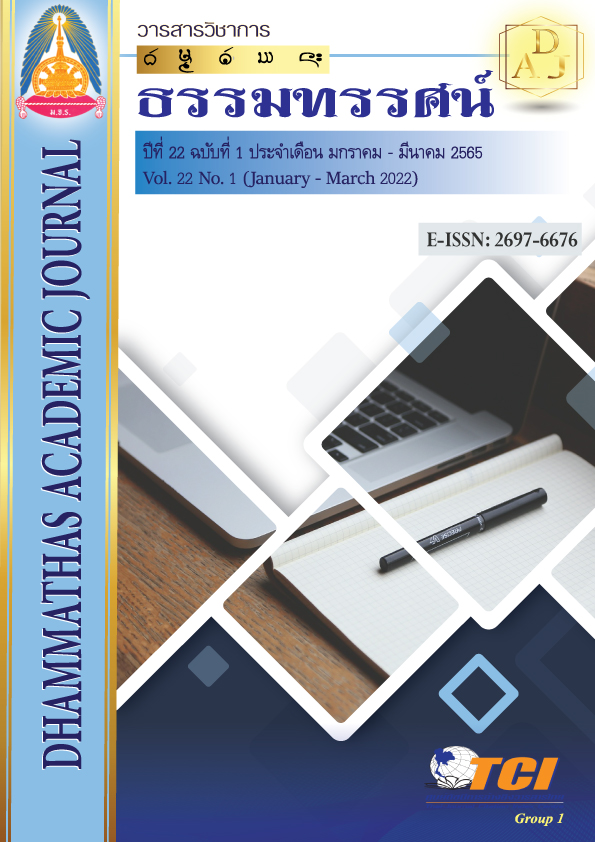Developing Online Teaching Skills For students English Faculty of Humanities Mahamakut Buddhist University Lanna Campus
Main Article Content
Abstract
The objectives of this research were to: 1) study the effective and effective online teaching and learning model can be adapted to suit students in the English language Faculty of Humanities Mahamakut Buddhist University, Lanna campus, 2) suggest the development of students' online teaching skills and 3) study the students' satisfaction with online teaching and learning. It was a mixed-use research, both quantitative and qualitative research. The research sample selected a specific sample group. By choosing to study only for bachelor's degree students English branch the Faculty of Humanities Year 2, 3 and 4 used questionnaires and interview forms together with group discussions as tools. To collect information using descriptive statistics and inferential statistics in data analysis.
The results of the research were as follows:
1. An efficient and effective online teaching-learning model. Which can be adapted to suit students. There are 3 formats: 1) online teaching and learning format by developing appropriate teaching media, 2) an online teaching-learning format by developing a group of learners and members; and 3) an online teaching and learning model.
2. Improving the teaching and learning management of the faculty found that teaching content should be added in the form of video clips or in the form of cache ports. Many channels to increase teaching efficiency.
3. Satisfaction with online teaching and learning of students. It was found that the satisfaction of the lessons moderate lesson design moderate and in terms of use is at a high level.
Article Details

This work is licensed under a Creative Commons Attribution-NonCommercial-NoDerivatives 4.0 International License.
เพื่อให้เป็นไปตามกฎหมายลิขสิทธิ์ ผู้นิพนธ์ทุกท่านต้องลงลายมือชื่อในแบบฟอร์มใบมอบลิขสิทธิ์บทความ ให้แก่วารสารฯ พร้อมกับบทความต้นฉบับที่ได้แก้ไขครั้งสุดท้าย นอกจากนี้ ผู้นิพนธ์ทุกท่านต้องยืนยันว่าบทความ ต้นฉบับที่ส่งมาตีพิมพ์นั้น ได้ส่งมาตีพิมพ์เฉพาะในวารสาร วิชาการธรรม ทรรศน์ เพียงแห่งเดียวเท่านั้น หากมีการใช้ ภาพหรือตารางของผู้นิพนธ์อื่นที่ปรากฏในสิ่งตีพิมพ์อื่นมาแล้ว ผู้นิพนธ์ต้องขออนุญาตเจ้าของลิขสิทธิ์ก่อน พร้อมทั้ง แสดงหนังสือที่ได้รับการยินยอมต่อบรรณาธิการ ก่อนที่บทความจะได้รับการตีพิมพ์References
ทวีโภค เอี่ยมจรูญ. (2563). ความสัมพันธ์ระหว่างการเปิดรับความรู้ การใช้ประโยชน์กับความพึงพอใจการเรียนแบบออนไลน์ (Online learning) ของนักศึกษาระดับปริญญาตรี มหาวิทยาลัยหัวเฉียวเฉลิมพระเกียรติ. ศิลปศาสตร์ปริทัศน์, 15(1), 26-41.
ถนอมพร เลาหจรัสแสง. (2545). Designing e-Learning: หลักการออกแบบและสร้างเว็บ เพื่อการเรียนการสอน. กรุงเทพฯ: อรุณ.
บุญชม ศรีสะอาด. (2556). วิธีการทางสถิติสำหรับการวิจัย เล่ม 1. (พิมพ์ครั้งที่ 5). กรุงเทพฯ: สุวีริยาสาส์น.บุษกร เชี่ยวจินดากานต์. (2556). พหุกรณีศึกษาการบริหารเชิงกลยุทธ์ของศูนย์เทคโนโลยี และสื่อสารการศึกษาตามปัจจัยแห่งความสำเร็จสำหรับการเรียนทางไกลออนไลน์ในระดับอุดมศึกษา. (วิทยานิพนธ์ครุศาสตรดุษฎีบัณฑิต). กรุงเทพฯ: จุฬาลงกรณ์มหาวิทยาลัย.
ปัญญา เปรมปรีดิ์. (2544). เทคโนโลยีคืออะไร. คอมพิวเตอร์รีวิว, 11(209), 45-53.
พวงรัตน์ ทวีรัตน์. (2543). วิธีการวิจัยทางพฤติกรรมศาสตร์และสังคมศาสตร์. (พิมพ์ครั้งที่ 8). กรุงเทพฯ: สำนักทดสอบทางการศึกษาและจิตวิทยา มหาวิทยาลัยศรีนครินทรวิโรฒ.
วัฒนพร จตุรานนท์. (2562). การศึกษาพฤติกรรมการเรียนออนไลน์และความพึงพอใจที่มีต่อการจัดการเรียนรู้ภาษาจีนผ่านระบบออนไลน์ของนิสิตหลักสูตรการศึกษาบัณฑิต สาขาภาษาจีน คณะศึกษาศาสตร์ มหาวิทยาลัยบูรพา ภาคการศึกษาฤดูร้อน ปีการศึกษา 2562 ตามมาตรการและการเฝ้าระวังการระบาดของโรคไวรัสโคโรนา 2019. วารสารวิชาการภาษาและวัฒนธรรมจีน, 7(2), 291-310.
วิจารณ์ พานิช. (2555). วิถีสร้างการเรียนรู้เพื่อศิษย์ ในศตวรรษที่ 21. กรุงเทพฯ: มูลนิธิสดศรี-สฤษดิ์วงศ์.
วิทยากร เชียงกูล. (2542). รายงานสภาวะการศึกษาไทย ปี 2541: วิกฤติและโอกาสในการปฏิรูปการศึกษาและสังคมไทย. กรุงเทพฯ: สำนักงานคณะกรรมการการศึกษาแห่งชาติ.
เสถียร พูลผล และปฏิพล อรรณพบริบูรณ์. (2563). การสำรวจความคิดเห็นของนักศึกษาเภสัชศาสตร์ที่มีต่อการเรียนออนไลน์ในช่วงโควิด - 19 เพื่อออกแบบแนวทางการจัดการเรียนรู้รูปแบบใหม่ของคณะเภสัชศาสตร์ มหาวิทยาลัยสยาม. (รายงานการวิจัย). กรุงเทพฯ: สมาคมเครือข่ายการพัฒนาวิชาชีพอาจารย์และองค์กรระดับอุดมศึกษาแห่งประเทศไทย และสำนักงานปลัดกระทรวงการอุดมศึกษา วิทยาศาสตร์ วิจัยและนวัตกรรม.
อโรชา ทองลาว. (2563). การศึกษาความพึงพอใจของนิสิตมหาวิทยาลัยเกษตรศาสตร์ วิทยาเขตกำแพงแสน ต่อการจัดการเรียนการสอนรูปแบบออนไลน์ ประจำภาคต้น ปีการศึกษา 2563. วารสารศิลปศาสตร์และอุตสาหกรรมบริการ, 4(2), 617-632.
Likert, R. A. (1932). Technique for the Measurement of Attitudes. Arch Psychological, 25(140), 1-55.

